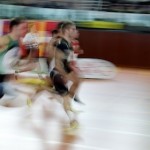This post continues down the same theme as the article I wrote regarding return to play assessment for upper limb injuries. If you have not read this yet, I strongly recommend you read it first. Along the same vein, this article loosely outlines my sideline assessment for a lower limb injury. The process guides my decision making about an athlete’s ability to return to play. Of course, it also gives me information as to the likely quality of the performance the athlete will give upon return, which can help the coaching staff decide whether they will risk an “injured player”.
As I said previously the assessment frequently differs for each specific injury, however, I hope this may stimulate thought on the way sports physiotherapists determine RTP capability.
DIAGNOSIS, PAIN, RANGE OF MOTION
In terms of diagnosis, pain and range of motion, my stance is exactly that same as in the aforementioned article. Again, if you have not read this article yet, I cannot tell you again, read it first (or even read it again if you like).
Now, in terms of specificity to the lower limb, these components are discussed below.
SKILLS
Testing skills is important for lower limb injuries, however, its importance varies not only between sports but between positions in sports. If you are covering football (or soccer if you want to swear) then examining the athletes ability to handle the ball is essential. In AFL players, certain rugby league players, and many other sports you will need to assess kicking the football: short, high and long. This is an explosive lower limb action, and will test many lower limb injuries.
FUNCTION
Again, we get into the meat of the assessment. The functional assessment should be relevant, challenging and efficient. This irreplaceable component of the sideline RTP assessment will normally include:
Straight Lines: the athlete starts by walking straight lines. Then, gradually, you build up pace. Starting by jogging and eventually sprinting. The athlete should have a required amount of speed for their position and sport.
Full ROM Double Leg Squat: the athlete will need to be able to do an (essentially) full double leg squat. However, if this is not relevant it may not be required.
Full Kneel: the athlete should be able to kneel down and sit on heels. Again, some athletes cannot do this when not injured so make it relevant.
3 Hop Power: a simple 3 hop test to assess power deficits.
Zig-Zag Sprinting: this may include cuts, side-steps or whatever relevant. If playing soccer then the athlete can do this with a ball to assess their integration of speed and control.
Single Leg Leap for Height: whilst only used for the back 3 (fullback and wingers) in league this is certainly relevant in sports like AFL or basketball.
YOU’RE IN THE CLEAR
As I’ve stated previously, if the athlete passes these criteria it is more likely that they will be able to handle the intensity of the game. This is more objective than just asking “do you reckon you will be right”. Whilst it may seem quite involved, after the diagnosis, the entire process generally takes about two or three minutes.
Whilst you do not need to follow the return to play assessment discussed here, there is no doubt you do need an objective and structured sideline assessment. If you do not, you will be ineffective and disorganised, and eventually send players back on the field who should not be out there. Inevitably, this will reflect poorly on you and your clinical reasoning.
What would/do you do differently? Comment here or catch me on Twitter or Facebook.
Related Posts
Comments










Great article. Newly graduated physio, just started working with a football team, this is exactly what i needed. Keep up the good work!
Thanks Joe, I appreciate that! Best of luck!